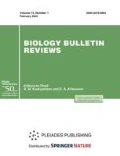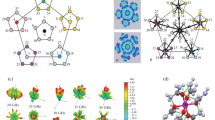Abstract—Group-theoretical analysis of the pseudosymmetry of two-dimensional images of aquatic organisms of the classes Conjugatophyceae, Bacillariophyceae, Acantharia, and Asteroidea and the symmetry transformations in the ontogeny of echinoderms has been performed for the first time in the original BioPsLeaf and BioPsFlower software, and the results of the analysis are presented below. Published materials, including graphic illustrations from Haeckel’s book Künstformen der Natur were the sources of the two-dimensional images of aquatic organisms used in the study. The choice of aquatic organisms was largely determined by the Curie principle, which imposes restrictions on the symmetry groups of living organisms with consideration of the specific habitat. Analysis of the organisms from the considered classes showed that the invariance (symmetry) of a biological object that can be roughly described by the Cnv group of operations of the Schoenflies system could be generally characterized by two numerical parameters, i.e., the minimum values of the degrees of pseudosymmetry both among all of its local maxima for turn operations (ηr) and mirror reflections (ηb). Analysis of Asterina amurensis as an example showed that the complete starfish metamorphosis could be represented by symmetry transformations in the form of the following series: С4v → С2v → Cs → C5v, which reflects the natural transition from rotational symmetry to bilateral and again to the rotational due to the biological characteristics of the organism at different stages of development. This series is consistent with the Curie principle: a system under external influence changes its point symmetry in such a way that only the symmetry operations in common with the symmetry operations of the influence are preserved. It is emphasized that exactly the group theory enables the characterization of an object’s invariance with respect to spatial transformations—in other words, its symmetry. In turn, the identification of invariants as a certain class of objects makes it possible to determine their structural basis and thus can help to find the invariable in the variable.









Similar content being viewed by others
REFERENCES
Afanas’eva, M.S. and Amon, E.O., Symmetry in radiolarian skeletons, Litosfera, 2014, no. 2, pp. 39–49.
Beklemishev, V.N., Osnovy sravnitel’noi anatomii bespozvonochnykh (Fundamentals of Comparative Anatomy of Invertebrates), Moscow: Nauka, 1964, in 2 vols.
Belousov, L.V., Symmetry transformations in the development of organisms, in Morfogenez v individual’nom i istoricheskom razvitii: simmetriya i asimmetriya (Morphogenesis in Individual and Historical Development: Symmetry and Asymmetry), Moscow: Paleontol. Inst., Ross. Akad. Nauk, 2013, pp. 6–21.
Born, M., Physics in My Generation, New York: Springer-Verlag, 1968.
Chudaev, D.A., Kupreeva, M.D., and Gololobova, M.A., On the studies of the species of Navicula bory sensu stricto (Diatomophyceae) of Moskva River, Moscow Univ. Biol. Sci. Bull., 2015, vol. 70, no. 2, pp. 91–98.
Chuprunov E.V., Simmetriya i psevdosimmetriya kristallov (Symmetry and Pseudosymmetry of Crystals), Nizhny Novgorod: Nizhegorod. Gos. Univ., 2015.
Corley, S.B., Carpenter, R., Copsey, L., and Coen, E., Floral asymmetry involves an interplay between TCP and MYB transcription factors in Antirrhinum, Proc. Nat. Acad. Sci. U.S.A., 2005, vol. 102, no. 14, pp. 5068–5073.
Danilov, Yu.A., Theoretical-group properties of mathematical models in biology, in Matematicheskaya biologiya razvitiya (Mathematical Biology of Development), Zotin, A.I. and Presnov, E.V., Eds., Moscow: Nauka, 1982, pp. 5–15.
Donoghue, M.J., Ree, R.H., and Baum, D.A., Phylogeny and evolution of flower symmetry in the Asteridae, Trends Plant Sci., 1998, vol. 3, pp. 311–317.
Endress, P.K., Symmetry in flowers: diversity and evolution, Int. J. Plant Sci., 1999, vol. 160, suppl. 6, pp. S3–S23.
Endress, P.K., The immense diversity of floral monosymmetry and asymmetry across angiosperms, Bot. Rev., 2012, vol. 78, pp. 345–397.
Gelashvili, D.B., Chuprunov, E.V., and Iudin, D.I., Structural-information indices of fluctuating asymmetry of bilaterally symmetrical organisms, Zh. Obshch. Biol., 2004, vol. 65, no. 4, pp. 377–385.
Gelashvili, D.B., Chuprunov, E.V., Marychev, M.O., Somov, N.V., Shirokov, A.I., and Nizhegorodtsev, A.A., The application of group theory to the description of pseudosymmetry, Biol. Bull. Rev., 2011, vol. 1, no. 3, pp. 185–198.
Gelashvili, D.B., Chuprunov, E.V., Somov, N.V., Marychev, M.O., Nizhegorodtsev, A.A., Markelov, I.N., and Yakimov, V.N., Psevdosimmetriya v zhivoi prirode (Pseudosymmetry in Living Nature), Gelashvili, D.B. and Chuprunov, E.V., Eds., Nizhny Novgorod: Nizhegorod. Gos. Univ., 2016.
Gilyarov, M.S., Functional role of symmetry for organisms, Zool. Zh., 1944, vol. 23, no. 5, pp. 213–215.
Gol’danskii, V. I. and Kuz’min, V.V., Spontaneous breaking of mirror symmetry in nature and the origin of life, Sov. Phys. Usp., 1989, vol. 32, no. 1, pp. 1–29.
Goncharov, A.A., Problems of systematics conjugates (Zygnematophyceae, Streptophyta) in terms of molecular-phylogenetic data, Bot. Zh., 2009, vol. 94, no. 10, pp. 1417–1438.
Haeckel, E., Generelle Morphologie der Organismen. Allgemeine Grundzüge der Organischen Formen-Wissenschaft, Mechanisch Begründet Durch die von Charles Darwin Reformirte Descendenztheorie, Berlin: Georg Reimer, 1866, vol. 1.
Haeckel, E., Kunstformen der Natur, Leipzig: Verlag Bibliogr. Inst., 1899–1904.
Hileman, L., Trends in flower symmetry evolution revealed through phylogenetic and developmental genetic advances, Philos. Trans. R. Soc. B, 2014, vol. 369, no. 1648, p. 20130348. https://doi.org/10.1098/rstb.2013.0348
Isaeva, V.V., Symmetry transformations in ontogenesis and evolution, in Morfogenez v individual’nom i istoricheskom razvitii: simmetriya i asimmetriya (Morphogenesis in Individual and Historical Development: Symmetry and Asymmetry), Moscow: Paleontol. Inst., Ross. Akad. Nauk, 2013, pp. 22–43.
Kashenko, S.D., Chronology of development in the starfish Asterina pectinifera from Vostok Bay, Sea of Japan, Russ. J. Mar. Biol., 2005, vol. 31, no. 4, pp. 261–264.
Mordukhai-Boltovskoi, D.D., Geometriya radiolyarii (Geometry of Radiolarians), Moscow: Librokom, 2012, 2nd ed.
Petukhov, S.V., Biomekhanika, bionika i simmetriya (Biomechanics, Bionics, and Symmetry), Moscow: Nauka, 1981.
Preston, J.C., Hileman, L.C., Developmental genetics of floral symmetry evolution, Trends Plant Sci., 2009, vol. 14, pp. 147–154.
Shubnikov, A.V. and Koptsik, V.A., Simmetriya v nauke i iskusstve (Symmetry in Science and Art), Moscow: Nauka, 1972.
Somov, N.V. and Chuprunov, E.V., Pseudosymmetry software for studying the pseudosymmetry of crystal atomic structures, Crystallogr. Rep., 2014, vol. 59, no. 1, pp. 137–139.
Stewart, I., Why Beauty Is Truth: A History of Symmetry, New York, NY: Basic Books, 2007.
Thompson, D’A.W., On Growth and Form, Cambridge: Cambridge Univ. Press, 2000, pp. 268–325.
Tverdislov, V.A., Sidorova, A.E., and Yakovenko, L.V., From symmetries to the laws of evolution. I. Chirality as a means of active media stratification, Biophysics (Moscow), 2012, vol. 57, no. 1, pp. 120–126.
Urmantsev, Yu.A., Simmetriya prirody i priroda simmetrii (The Symmetry of Nature and the Nature of Symmetry), Moscow: Mysl’, 1974.
Voitekhovskii, Yu.L., Geometrical motives in the Tetraodontiformes fishes morphology, Zh. Obshch. Biol., 2009, vol. 70, no. 3, pp. 257–261.
Voitekhovskii, Yu.L., Symmetry, asymmetry, dissymmetry, and enantiomorphism of polyhedral forms, in Morfogenez v individual’nom i istoricheskom razvitii: simmetriya i asimmetriya (Morphogenesis in Individual and Historical Development: Symmetry and Asymmetry), Moscow: Paleontol. Inst., Ross. Akad. Nauk, 2013, pp. 44–53.
Voitekhovskii, Yu.L., Timofeeva, M.G., and Stepenshchikov, D.G., The Curie principle and the morphological diversity of Pandorina morum (Mull.) Bory colonies (Volvocaceae), Zh. Obshch. Biol., 2006, vol. 67, no. 3, pp. 206–211.
Weyl, H., Symmetry, Princeton, NJ: Princeton Univ. Press, 1952.
Zakharov, V.M., Asimmetriya zhivotnykh (Asymmetry of Animals), Moscow: Nauka, 1987.
Zarenkov, N.A., Biosimmetrika (Biosymmetry), Moscow: Librokom, 2009.
Zhizn’ zhivotnykh. Tom 3. Bespozvonochnye (Life of Animals, Vol. 3: Invertebrates), Zenkevich, L.A., Ed., Moscow: Prosveshchenie, 1968.
Author information
Authors and Affiliations
Corresponding author
Additional information
Translated by S. Semenova
Rights and permissions
About this article
Cite this article
Gelashvili, D.B., Chuprunov, E.V., Somov, N.V. et al. Group-Theoretical Analysis of Symmetry Transformations on the Example of Some Aquatic Organisms. Biol Bull Rev 9, 203–214 (2019). https://doi.org/10.1134/S2079086419030058
Received:
Published:
Issue Date:
DOI: https://doi.org/10.1134/S2079086419030058




